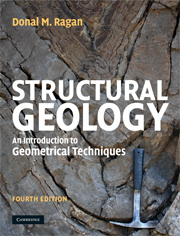Book contents
- Frontmatter
- Contents
- Preface
- Acknowledgements
- 1 Structural planes
- 2 Thickness and depth
- 3 Lines and intersecting planes
- 4 Planes and topography
- 5 Stereographic projection
- 6 Rotations
- 7 Vectors
- 8 Faults
- 9 Stress
- 10 Faulting
- 11 Deformation
- 12 Strain
- 13 Flow
- 14 Folds
- 15 Parallel folds
- 16 Similar folds
- 17 Folds and topography
- 18 Structural analysis
- 19 Tectonites
- 20 Drill hole data
- 21 Maps and cross sections
- 22 Block diagrams
- Appendices
- References
- Index
14 - Folds
Published online by Cambridge University Press: 05 June 2012
- Frontmatter
- Contents
- Preface
- Acknowledgements
- 1 Structural planes
- 2 Thickness and depth
- 3 Lines and intersecting planes
- 4 Planes and topography
- 5 Stereographic projection
- 6 Rotations
- 7 Vectors
- 8 Faults
- 9 Stress
- 10 Faulting
- 11 Deformation
- 12 Strain
- 13 Flow
- 14 Folds
- 15 Parallel folds
- 16 Similar folds
- 17 Folds and topography
- 18 Structural analysis
- 19 Tectonites
- 20 Drill hole data
- 21 Maps and cross sections
- 22 Block diagrams
- Appendices
- References
- Index
Summary
Introduction
A fold is a distortion of a volume of rock material that manifests itself as a bend or nest of bends in linear or planar elements (Hansen, 1971, p. 8). Many folds involve elements which were originally planar. Sedimentary bedding is the common example, and this is an important case because the geometry of the fold then represents an important indicator of the nature of the deformation. In particular, its features can be correlated with certain aspects of rotation and stretch. However, folds may also develop from originally curved elements, and the problem of relating the features to the deformation is much more severe.
Folding occurs when pre-existing elements are transformed into new curviplanar or curvilinear configurations, whatever their original state. Thus folding is just an inhomogeneous deformation which acts on a body of material containing linear or planar elements (see Fig. 11.1). It is worth noting, however, that a deformation which produces a fold in one situation may not in another. Planar or linear elements may be entirely absent from the rock mass, and therefore there is nothing to mark a fold form. It is also possible that initially curved elements might become planar or linear, or that the elements may be so oriented as to remain planar or linear (Ramsay, 1967, p. 473).
In the following sections, a number of relatively simple geometrical properties of folded surfaces are explored.
- Type
- Chapter
- Information
- Structural GeologyAn Introduction to Geometrical Techniques, pp. 369 - 409Publisher: Cambridge University PressPrint publication year: 2009

